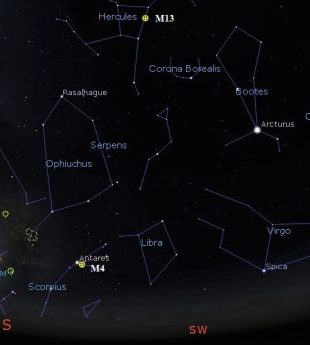This Week’s Sky at a Glance, 2025 July 05 – Ju1y 12
This Week’s Sky at a Glance, 2025 July 05 – Ju1y 12
The dome of the night sky appears to be two dimensional, which led the ancients to propose that the stars were embedded on a crystal sphere beyond the wanderers of the Sun, Moon and five planets. We now know that the stars are much farther than the planets, but how much farther? Neptune is the most distant planet from the Sun, about three times farther than Saturn and 30 times farther than Earth. Sunlight takes 4.2 hours to reach Neptune but 4.2 years to reach the closest star, Proxima Centauri. The nearest star we can see easily from New Brunswick is Sirius at 8.6 light years.
Although the constellations appear to be distinct figures of related stars, often those stars are at vastly different distances. Rasalhague, the brightest star of Ophiuchus and which marks his head, is 49 light years away, while the one at his waist is about ten times farther. Rasalhague is closer to us than it is to some of the other stars that form the constellation. The constellation shapes are a matter of perspective but they will look the same from Neptune as they do from Earth.
Near Antares in Scorpius is the globular cluster M4, one of the nearest such clusters at 7000 light years. M13 in Hercules is more than three times distant, and M31, the Andromeda Galaxy, is about one hundred times farther than M13. The most distant object accessible by a medium-size backyard telescope is the quasar (an extremely luminous active galaxy) 3C 273 in Virgo, which is a thousand times farther than M31. And sometimes in Saint John I can barely see across the street.
This Week in the Solar System
Saturday’s sunrise is at 5:43 and sunset will occur at 9:14, giving 15 hours, 31 minutes of daylight. Next Saturday the Sun will rise at 5:48 and set at 9:10, giving 15 hours, 22 minutes of daylight.
The Moon is near Antares in Scorpius on Monday morning and it is full on Thursday. Mercury sets 80 minutes after sunset this weekend and one hour after sunset next weekend. Mars is now setting before midnight and it is starting to creep sunward. Saturn rises around 12:30 am this week with Neptune being just above it. On Sunday morning Uranus will be half a binocular field above Venus but try to see it well before 5:00 to avoid bright twilight. Jupiter is in the morning sky, visible in twilight next weekend when it rises an hour before the Sun.
The Saint John Astronomy Club meets in the Rockwood Park Interpretation Centre this Saturday at 7 pm.

